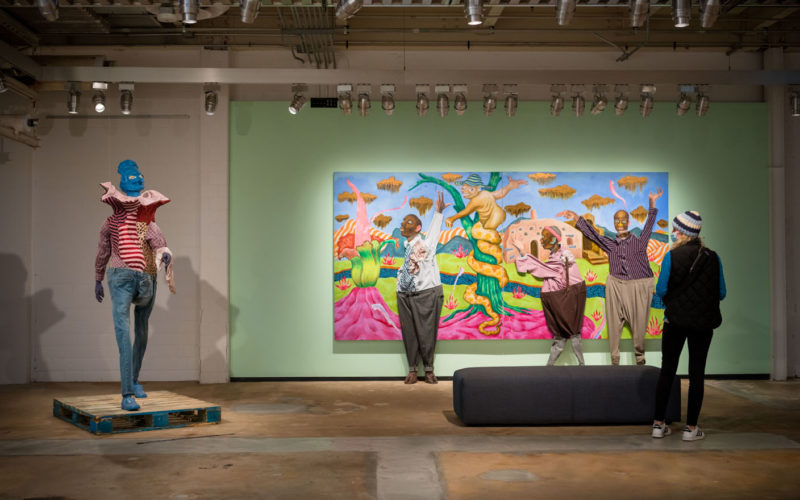JOCELYN MURPHY
jmurphy@nwadg.com
In preparing for the newest temporary exhibition at the Momentary multidisciplinary arts space in Bentonville, there was a reluctance to even use the word “fashion” in the title — though it would go on to become “In Some Form or Fashion.” Organizers did not want to mislead audiences to believe it was a fashion exhibition in the traditional sense, reveals Kaitlin Garcia-Maestas, associate curator.
“Rather, these artists are, through their artwork that is sort of housed within the art world, thinking about and critiquing the fashion industry,” Garcia-Maestas says, pointing to the celebratory nature of “fashion as art” often associated with clothing or textile exhibition.
The material medium connects the six artists presented in the building-wide, Momentary-organized exhibition. But so, too, do the multiple layers of meaning and critique that “start to converse with one another when they’re installed side by side.”
“All of the artists in the exhibition, … are really thinking about what are the socio-cultural implications of fashion,” Garcia-Maestas demonstrates. “Ideas of global consumerism, mass consumption, cycles of colonialism — how do these elements deconstruct or reconstruct these ideas around gender, race and class?”
Some of those themes also hearken back to the Momentary’s factory origins. The six contemporary, mixed-media artists included were invited to respond to the venue’s industrial architecture to create site-specific and responsive works.
“It was important to me that we thought not just about what the architecture looks like today, but what was the history of the building? And how are those histories embedded in the story that we tell through our exhibition?” Garcia-Maestas says, thinking back to the exhibition’s inception. “In thinking about this site as a former site for manufacturing labor, specifically, it felt like there was a nice connection to some of the ideas of mass consumption and production that are happening within the textiles included in this exhibition.”
One such example is found in Pia Camil’s “Skins Shirt Curtain” — a 65-foot-long, nearly 10-foot-tall curtain constructed from T-shirts. On the back of the curtain, viewers can find tags with the garments’ countries of origin while on the front, American slogans, political ads and logos paint a different portrait of consumption and labor and who might be harmed in their processes.
Likewise, Troy Montes-Michie’s work truly “embraced the spirit of the exhibition,” Garcia-Maestas posits. In thoughtfully approaching the architecture of the site, Montes-Michie’s work feels at home in the space, she says, while reflecting an item capable of (and used to) both advertise and conceal one’s race and sexuality.
“I think it’s helpful for visitors to have the context of these works, but I also just hope the visitors are able to have fun and appreciate the tactile nature of all of these works,” Garcia-Maestas offers. “Because it’s hard to look at them and not want to touch some of them, even though you can’t touch them. Wendy Red Star’s feather dresses are so beautiful and so fun and vibrant. And Eric Mack’s hanging textiles are so dynamic, beautiful. I hope that visitors are able to find an escape and be able to immerse themselves in textile art, because that’s not something that the Momentary has had a lot of opportunity to show.”
And it’s a presentation Garcia-Maestas insists should be seen in person to fully appreciate the visual complexities and deeper layers on display.
“Coming out of this, sort of, pandemic digital moment, we’ve all gotten so accustomed to feeling like we can see and understand a work digitally,” she notes. “Textiles just don’t translate digitally very well. So it is a really rewarding experience to actually come and see the works in person. And then these ideas really start to click — because we all wear clothing, right?
“We all have memories that are associated with specific textiles, colors, materials, textures, and you start to find your own relationship to the work,” she adds. “So it’s been interesting; most people that I talk to, their favorite installation is different. Sometimes we have exhibitions, and there are clear favorites of work in the show. But I think this show, because textiles have all these embedded memories and signifiers, people respond very differently.”
__
FAQ
‘In Some Form or Fashion’
WHEN — Through March 27
WHERE — The Momentary, 507 S.E. St. in Bentonville
COST — Free
INFO — 367-7500, themomentary.org



